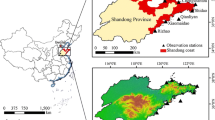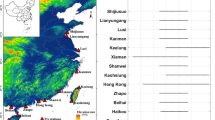Abstract
Extreme water levels are related to astronomical tides and storm surges. Eleven typhoon systems, which have caused extreme water level rises, were selected based on 60-yr water level data from the Xiamen tide gauge station. In these 11 typhoon systems, the astronomical tide component accounts for 71%–95% of the total water level. The Gumbel distribution of extreme water level rise was estimated, and the impact of typhoon surges on water levels during the return period was analyzed. The extreme tide levels caused by typhoons Herb (1996) and Dujuan (2015) are much higher than those of other typhoons and correspond to the return period of 76 yr and 71 yr, respectively. The differences of sea levels in the presence and absence of these two typhoons in the 10–100 yr return period are 5.8–11.1 cm. For the 100-yr return period, the total risks within 10, 25, 50, and 100 yr increase by 94.3%, 85.4%, 72.9%, and 54.4%, respectively, if the Herb and Dujuan are not considered. Assuming that typhoon Herb (1996) occurred during the highest astronomical tide, it will produce a water level higher than that of the 1000-yr return period. Sea level rise has an important influence on the water level return period, and the contribution of nonlinear sea level rise in the next 100 yr is estimated to be 10.34%.
Similar content being viewed by others
References
Dong, J. X., Zhang, T. Y., and Fu, X., 2008. Calculation of the storm surges in the Shacheng Bay in Fujian Province in 100 years return periods. Marine Science Bulletin, 27: 9–16.
Doodson, A. T., 1921. The harmonic development of the tide-generating potential. Geophysical Journal Royal Astronomical Society, 100: 305–329.
Doodson, A. T., 1928. The analysis of tidal observations. Philosophical Transactions of the Royal Society of London, 227: 223–279.
Fan, L. L., and Wang, Y. Y., 2017. Parameter estimation and case analysis of based on generalized extreme value distribution. Journal of Capital Normal University (Natural Science Edition), 38 (3): 13–17 (in Chinese with English abstract).
Fisher, R. A., and Tippett, L. H. C., 1928. Limittimg forms of the frequency distribution of the largest or smaHest member of a sample. Mathematical Proceedings of the Cambridge Philosophical Society, 24: 180–190.
Han, G., and Huang, W., 2008. Pacific decadal oscillation and sea level variability in the Bohai, Yellow, and East China Seas. Journal of Physical Oceanography, 38: 2772–2783.
Hou, R. K., 1993. Calculating the annual maximum water level using the Gumbel extreme value distribution. Marine Science Bulletin, 3: 126–129.
Huang, W. R., Xu, S. D., and Nnaji, S., 2008. Evaluation of GEV model for frequency analysis of annual maximum water levels in the coast of United States. Ocean Engineering, 35 (11–12): 1132–1147.
Jiang, Y. W., Wu, P. M., and Xu, J. D., 2000. A model with interaction of tide and surge for Xiamen Harbor. Acta Oceanologica Sinica, 22: 1–6.
Liu, X., Liu, Y., Guo, L., Rong, Z. R., Gu, Y. Z., and Liu, Y. H., 2010. Interannual changes of sea level in the two regions of East China Sea and different responses to ENSO. Global and Planetary Change, 72: 215–226.
Pawlowicz, R., Beardsley, B., and Lentz, S., 2002. Classical tidal harmonic analysis including error estimates in MATLAB using T-TIDE. Computers and Geosciences, 28 (8): 929–937.
Peter, B., 2017. Tide-surge historical assessment of extreme water levels for the St. Johns River: 1928–2017. Journal of Hydrology, 553: 624–636.
Pirazzoli, P. A., and Tomasin, A., 2007. Estimation of return periods for extreme sea levels: A simplified empirical correction of the joint probabilities method with examples from the French Atlantic coast and three ports in the southwest of the UK. Ocean Dynamics, 57 (2): 91–107.
Qian, L. X., Wang, H. R., Zhang, R., and Jiao, Z. Q., 2019. Gumbel extreme hydrological frequency analysis model in situations of insufficient data. Advanced Engineering Sciences, 51 (5): 41–48 (in Chinese with English abstract).
Samuels, P. G., and Burt, N., 2002. A new joint probability appraisal of flood risk, proceedings of the institution of civil engineers. Proceedings of the Institution of Civil Engineers-Water, Maritime and Energy, 154 (2): 109–115.
Shi, X. W., Tan, J., Guo, Z. X., and Liu, Q. Z., 2013. A review of risk assessment of storm surge disaster. Advances in Earth Science, 28 (8): 866–874 (in Chinese with English abstract).
Sobey, R. J., 2005. Extreme low and high water levels. Coastal Engineering, 52 (1): 63–77.
Toro, G. R., Resio, D. T., Divoky, D., Niedoroda, A. W., and Reed, C., 2010. Efficient joint-probability methods for hurricane surge frequency analysis. Ocean Engineering, 37: 125–134.
Vogel, R. M., Tomas, W. J., and Mcmahon, T. A., 1993. Flood-flow frequency model selection in southwestern United States. Journal of Water Resources Planning and Management, 119: 353–366.
Walton, T. L. J., 2000. Distributions for storm surge extremes. Ocean Engineering, 27: 1279–1293.
Wang, H., Fan, W. J., Zhang, J. L., and Mu, L., 2011. The characteristics of sea level changes along the coast of China in recent 31 years. Marine Science Bulletin, 30 (6): 637–643 (in Chinese with English abstract).
Wang, H., Liu, K. X., Fan, W. J., Feng, J. L., Wang, G. S., Zhang, J. L., et al., 2018. Aanalysis on the sea level anomaly high of 2016 in China coastal area. Acta Oceanologica Sinica, 40 (2): 43–52 (in Chinese with English abstract).
Wang, J., and Jia, S. D., 1987. A program for extreme value analysis by using the Gumbel method. Marine Science Bulletin, 6: 87–91.
Wang, Y. J., Zhang, R., Qian, L. X., Ge, S. S., and Wang, F., 2016. Model for probabilistic risk assessment in extreme high water level caused by rising sea level and its application — A case study in Ningbo. Journal of Catastrophology, 31 (1): 213–218 (in Chinese with English abstract).
Wuebbles, D. J., Fahey, D. W., Hibbard, K. A., Dokken, D. J., Stewart, B. C., and Maycock, T. K., 2017. Climate Science Special Report: Fourth National Climate Assessment, Volume 1. Marine Research Press, Washington, D. C., 470pp.
Yuan, F. C., Wu, X. R., and Lu, J. F., 2018. Statistical characteristics of storm surges in central and southern Fujian coast. Marine Forecasts, 35: 68–75 (in Chinese with English abstract).
Zhang, H., and Sheng, J., 2015. Examination of extreme sea levels due to storm surges and tides over the Northwest Pacific Ocean. Continental Shelf Research, 93: 81–97.
Zhu, Y. M., and Li, Z. L., 2011. Sea level variation and the effect to water level extreme distribution estimate in South China. Transactions of Oceanology and Limnology, 4: 126–133 (in Chinese with English abstract).
Zuo, J., He, Q., and Chen, C., 2012. Sea level variability in East China Sea and its response to ENSO. Water Science and Engineering, 5: 164–174.
Acknowledgements
This study is supported by the National Key Research and Development Program of China (No. 2016YFC140 1103), the NSFC-Shandong Joint Foundation (No. U1706 226), the National Natural Science Foundation of China (No. 51779236), and the Open Fund of Shandong Province Key Laboratory of Ocean Engineering (No. kloe201903).
Author information
Authors and Affiliations
Corresponding author
Rights and permissions
About this article
Cite this article
Miao, Q., Yue, X., Yang, J. et al. Characteristics Analysis and Risk Assessment of Extreme Water Levels Based on 60-Year Observation Data in Xiamen, China. J. Ocean Univ. China 21, 315–322 (2022). https://doi.org/10.1007/s11802-022-4844-2
Received:
Revised:
Accepted:
Published:
Issue Date:
DOI: https://doi.org/10.1007/s11802-022-4844-2




